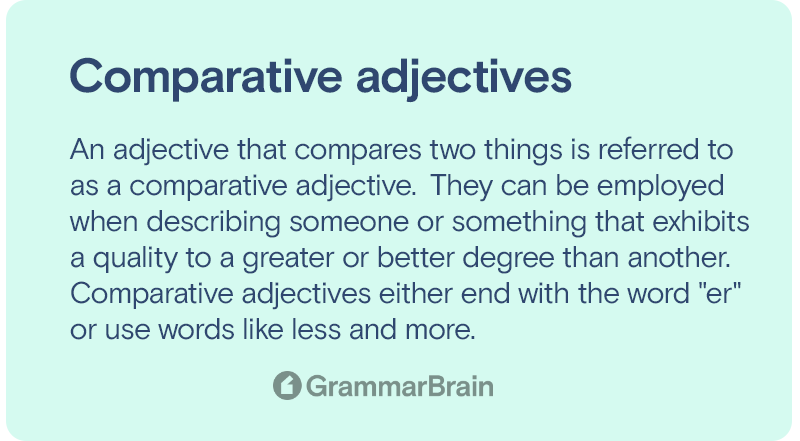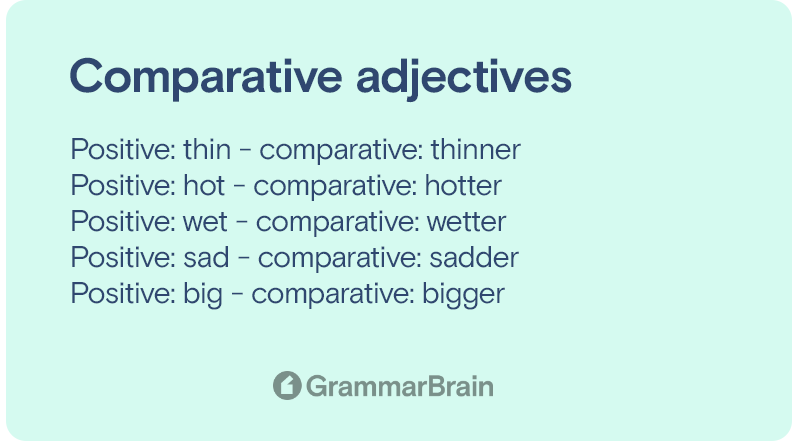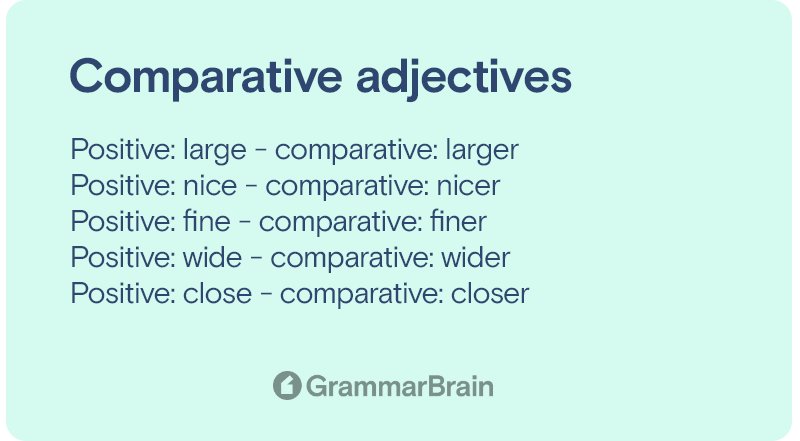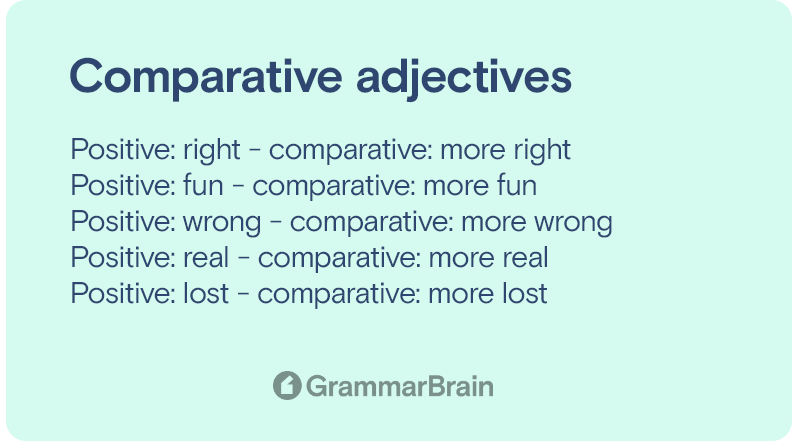What are comparative adjectives? How do comparative adjectives work? And how are they different from superlative adjectives? Comparing nouns like people, animals, or things to other nouns is one technique to define them. Adjectives are frequently used to compare two or more things. Two things can be compared using adjectives like “taller,” “fatter,” “smaller,” “more intelligent,” and “less beautiful.”

What is a comparative adjective?
An adjective that compares two things is referred to as a comparative adjective. They can be employed when describing someone or something that exhibits a quality to a greater or better degree than another. Comparative adjectives either end with the word “er” or use words like less and more.
Comparative adjectives examples:
Consider the examples given below:
- Lily is tall. (positive); Lily is taller than Jenna. (comparative)
- Lola’s cat is fat. (positive); Lola’s cat is fatter than Mary’s dog. (comparative)
- I need to wake up early since my dorm is far away from the college. (positive); I need to wake up earlier than my collegemates since my dorm is far away from the college. (comparative)
- Speaking Chinese is difficult. (positive); Speaking Chinese is more difficult than speaking French. (comparative)
- Riding a bike is fun. (positive); Riding a bike is more fun than playing football. (comparative)
Rules for constructing comparative adjectives
Comparative adjectives are formed from the positive forms of adjectives. The number of syllables present in the source adjectives determines the form of the comparative adjective. There are certain rules that need to be followed when forming comparative adjectives.
These include:
Adjectives with one syllable
If there is only a single syllable in the adjective, then the comparative form can be created by adding “er” to it.

Examples:
- Positive: small – comparative: smaller
- Positive: cold – comparative: colder
- Positive: tall – comparative: taller
- Positive: young – comparative: younger
- Positive: clean – comparative: cleaner
If the adjective ends with a consonant and a vowel precedes it, the consonant is doubled while forming comparative adjectives.

Examples:
- Positive: thin – comparative: thinner
- Positive: hot – comparative: hotter
- Positive: wet – comparative: wetter
- Positive: sad – comparative: sadder
- Positive: big – comparative: bigger
If the positive adjective has a “y” at the end, change the y to an “i” and add an “er” at the end while forming comparative adjectives.

Examples:
- Positive: tiny – comparative: tinier
- Positive: thirsty – comparative: thirstier
- Positive: jumpy – comparative: jumpier
- Positive: dry – comparative: drier
- Positive: healthy – comparative: healthier
If the positive adjective has an “e” at the end, simply add an “r” at the end while forming comparative adjectives.

Examples:
- Positive: large – comparative: larger
- Positive: nice – comparative: nicer
- Positive: fine – comparative: finer
- Positive: wide – comparative: wider
- Positive: close – comparative: closer
There are certain single-syllable adjectives that cannot be converted into the comparative form by adding “er,” even though the positive adjective has only a single syllable. In this case, comparative adjectives are formed by adding “more” to the positive adjective.

Examples:
- Positive: right – comparative: more right
- Positive: fun – comparative: more fun
- Positive: wrong – comparative: more wrong
- Positive: real – comparative: more real
- Positive: lost – comparative: more lost
Two-syllable adjectives
A two-syllable adjective can be modified into its comparative form by either adding “more” before the adjective or by adding “er” at the end. Though both variants are frequently used, many authors tend to use “more” when unsure of the comparative form.
Examples of adding “er” at the end:
- Positive: narrow – comparative: narrower
- Positive: simple – comparative: simpler
- Positive: quiet – comparative: quieter
- Positive: clever – comparative: cleverer
- Positive: safe – comparative: safer
Examples of adding “more” before the adjective
- Positive: normal – comparative: more normal
- Positive: careful – comparative: more careful
- Positive: tilted – comparative: more tilted
- Positive: tangled – comparative: more tangled
- Positive: broken – comparative: more broken
If the two-syllable adjective has a “y” in the end, change the y to an “i” and add an “er” at the end. It is also possible to add “more” before the adjective.
Examples:
- Positive: ugly – comparative: uglier
- Positive: happy – comparative: happier
- Positive: dirty – comparative: dirtier
- Positive: pretty – comparative: prettier
- Positive: busy – comparative: busier
Adjectives with three or more syllables
If the positive adjective has three or more syllables, then the comparative can be formed only by adding “more” in front of the adjective.
Examples:
- Positive: expensive – comparative: more expensive
- Positive: important – comparative: more important
- Positive: intelligent – comparative: more intelligent
- Positive: beautiful – comparative: more beautiful
- Positive: interesting – comparative: more interesting
Irregular adjectives
There are also some commonly used adjectives that have irregular comparative forms.
Examples:
- Positive: much – comparative: more
- Positive: far – comparative: further
- Positive: well – comparative: better
- Positive: little – comparative: less
- Positive: good – comparative: better
FAQs
What is the difference between comparative and superlative adjectives?
Though both comparative and superlative adjectives are derived from the positive adjective form, there is a difference in their structure and function.
Comparative adjectives either end with the word “er” or use words like less and more.
Whereas superlative adjectives either end with the word “est” or use words like least and most.
Comparative adjectives compare two things, whereas superlative adjectives compare more than two things.
Are there any exceptions to the rules used for forming comparative adjectives?
Though most comparatives are formed using the rules, there is some confusion regarding the term “handsome.” The comparative form should be “handsomer,” according to the rules. But over time, the simpler term “more handsome” has become popular in both written and spoken forms.
What are one syllable adjectives?
One syllable adjectives add “-er” or “-est” to the end for the superlative adjective form.
Can irregular comparative adjectives can base form?
Irregular comparative adjectives can also change the base form.
What are the rules for forming the superlative?
If adjective is consonant + single vowel + consonant spelling, the final consonant must get doubled.
Sources:
- Merriam Webster – comparative – Definition
- Wikipedia – Comparison (grammar)
- Thesaurus.com – What Are Comparative Adjectives And How Do You Use Them?
- Grammarly – What Are Comparative and Superlative Adjectives?
Inside this article
Fact checked:
Content is rigorously reviewed by a team of qualified and experienced fact checkers. Fact checkers review articles for factual accuracy, relevance, and timeliness. Learn more.
Core lessons
Glossary
- Abstract Noun
- Accusative Case
- Anecdote
- Antonym
- Active Sentence
- Adverb
- Adjective
- Allegory
- Alliteration
- Adjective Clause
- Adjective Phrase
- Ampersand
- Anastrophe
- Adverbial Clause
- Appositive Phrase
- Clause
- Compound Adjective
- Complex Sentence
- Compound Words
- Compound Predicate
- Common Noun
- Comparative Adjective
- Comparative and Superlative
- Compound Noun
- Compound Subject
- Compound Sentence
- Copular Verb
- Collective Noun
- Colloquialism
- Conciseness
- Consonance
- Conditional
- Concrete Noun
- Conjunction
- Conjugation
- Conditional Sentence
- Comma Splice
- Correlative Conjunction
- Coordinating Conjunction
- Coordinate Adjective
- Cumulative Adjective
- Dative Case
- Determiner
- Declarative Sentence
- Declarative Statement
- Direct Object Pronoun
- Direct Object
- Diction
- Diphthong
- Dangling Modifier
- Demonstrative Pronoun
- Demonstrative Adjective
- Direct Characterization
- Definite Article
- Doublespeak
- False Dilemma Fallacy
- Future Perfect Progressive
- Future Simple
- Future Perfect Continuous
- Future Perfect
- First Conditional
- Irregular Adjective
- Irregular Verb
- Imperative Sentence
- Indefinite Article
- Intransitive Verb
- Introductory Phrase
- Indefinite Pronoun
- Indirect Characterization
- Interrogative Sentence
- Intensive Pronoun
- Inanimate Object
- Indefinite Tense
- Infinitive Phrase
- Interjection
- Intensifier
- Infinitive
- Indicative Mood
- Participle
- Parallelism
- Prepositional Phrase
- Past Simple Tense
- Past Continuous Tense
- Past Perfect Tense
- Past Progressive Tense
- Present Simple Tense
- Present Perfect Tense
- Personal Pronoun
- Personification
- Persuasive Writing
- Parallel Structure
- Phrasal Verb
- Predicate Adjective
- Predicate Nominative
- Phonetic Language
- Plural Noun
- Punctuation
- Punctuation Marks
- Preposition
- Preposition of Place
- Parts of Speech
- Possessive Adjective
- Possessive Determiner
- Possessive Case
- Possessive Noun
- Proper Adjective
- Proper Noun
- Present Participle
- Prefix
- Predicate



